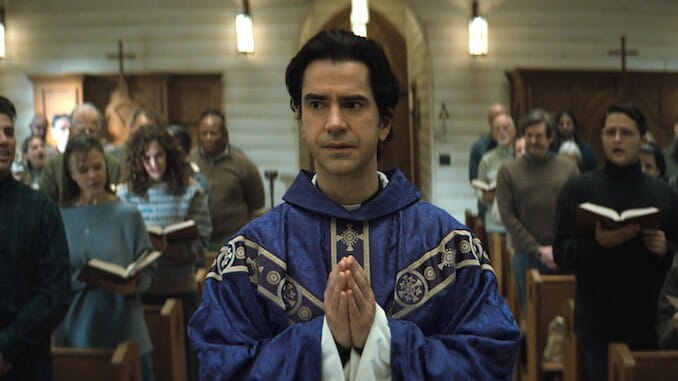Midnight Mass Wants to Transubstantiate Your Fear
Photo Courtesy of Netflix
On Midnight Mass’ Crockett Island, every islander feels rife with misfortune. The recent oil spill nearly annihilated the fish supply, tanking the island’s local fishing economy. Their homes splinter and peel in neglect to the ocean’s elements. The majority of residents have fled the island for lack of opportunity, leaving a paltry few behind. Only two ferries can take them to the mainland. Hope runs in short supply—and a major storm brews on the horizon.
There’s no shortage of reasons to be a God-fearing Christian on this island.
It’s no surprise then that Midnight Mass sends the audience straight to St Patrick’s Church, a small Catholic parish that functions as the heart of Crockett’s social life. Stewarded by the elderly Monsignor Pruitt and micromanaged by Bev Keane (Samantha Sloyan), a self-righteous young zealot, the church appears unextraordinary. But when Monsignor Pruitt fails to return from his trip from the Holy Land, a new enigmatic Father Paul (Hamish Linklater) takes to the pulpit in his place—and the meaning of faith for parishioners shifts in real time.
Everything beyond that for this seven-episode series is a true spoiler, but what can be said is that even with its dabblings in the supernatural, Midnight Mass (created by The Haunting’s Mike Flanagan, in his most recent collaboration with Netflix), is a show that burrows inwards instead of outwards. With both the physical claustrophobia of Crockett’s setting and the internal suffering of characters placed in center stage, Midnight Mass concerns itself with horrors within: addictive tendencies, secret histories, and questions of forgiveness and belief. At one glance, it’s a series that’s mined Catholic guilt for gold. In another, it’s a measured, yet spooky take on group psychology, the need for faith in sorrow, and the ethics of leadership with such vulnerable followers, weighing whether these impulses represent human goodness, evil, or simply nothing at all.
-

-

-

-

-

-

-

-

-

-

-

-

-

-

-

-

-

-

-

-

-

-

-

-

-

-

-

-

-

-

-

-

-

-

-

-

-

-

-

-








































